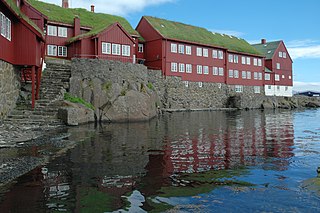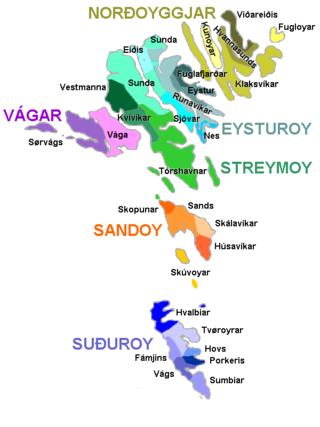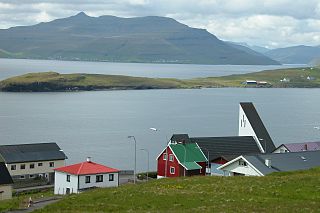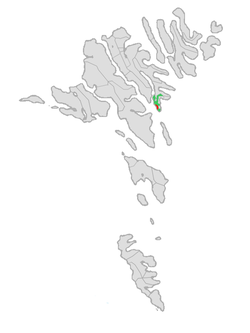
Tórshavn, usually locally referred to as simply Havn, is the capital and largest city of the Faroe Islands. It is located in the southern part on the east coast of Streymoy. To the northwest of the city lies the 347-meter-high (1,138 ft) mountain Húsareyn, and to the southwest, the 350-meter-high (1,150 ft) Kirkjubøreyn. They are separated by the Sandá River. The city itself has a population of 14,099 (2024), and the greater urban area has a population of 23,194, including the suburbs of Hoyvík and Argir.

The Faroe Islands are divided into 29 municipalities, six regions/shires and since 2007 there has been only one constituency, earlier there were seven constituencies. Each region has one sheriff.

Argir is a village in the Faroe Islands.

Fuglafjørður is a village on Eysturoy's east coast in the Faroe Islands. Its name means "fjord of birds".

Norðragøta, also just referred to as Gøta, is a village on Eysturoy island, Faroe Islands.

Klaksvík is the second largest town of the Faroe Islands behind Tórshavn. The town is located on Borðoy, which is one of the northernmost islands. It is the administrative centre of Klaksvík municipality.

Tvøroyri is a village on the north side of the Trongisvágsfjørður on the east coast of Suðuroy island in the Faroe Islands. Together with Froðba, Trongisvágur, Líðin and Øravík it forms Tvøroyri Municipality.

Hvalba is a village and a municipality in the Faroe Islands, which consists of Hvalba, Nes-Hvalba and Sandvík.

Toftir is a village in Nes Municipality on the island of Eysturoy, in the Faroe Islands. It is part of a chain of villages stretching over a distance of 10 kilometres on the east side of Skálafjørður (fjord) on Eysturoy island. The highest hill in Toftir, called Húkslond, is 129 metres high, and Nes Municipality is the only area in the Faroes which has no mountains above 200 metres.

Eysturoy is a region and the second-largest of the Faroe Islands, both in size and population.

Sørvágur is a village on the island of Vágar in the Faroe Islands.

Sandur is a village on the south coast of the island of Sandoy in the Faroe Islands. The Sandur hoard of silver coins, dating to the end of the 11th century, attests to the long history of the village. In January 2024, the population stood at 529.

Vágur, meaning bay, is a town and municipality on the island of Suðuroy, part of the Faroe Islands.

Kvívík is a village and municipality on the west coast of Streymoy in the Faroe Islands.

Nes is a village in Nes Municipality on the southwest coast of the Faroese island of Eysturoy.

Nes is a village on the Faroese island of Suðuroy located in the municipality of Vágur. It is located west of Porkeri and east of Vágur.

The following outline is provided as an overview of and topical guide to the Faroe Islands:

The Faroe or Faeroe Islands, or simply the Faroes, are an archipelago in the North Atlantic Ocean and an autonomous territory of the Kingdom of Denmark. The official language of the country is Faroese, which is closely related to and partially mutually intelligible with Icelandic.

The Faroe Islands are administratively divided in 29 municipalities (kommunur), with about 120 cities and villages. Until December 31, 2008, there were 34 municipalities, and until December 31, 2004, there were 48 municipalities. In the coming years the number of Faroese municipalities is expected to drop to somewhere between 7 and 15, as there is currently a rationale towards municipal amalgamation and a decentralization of public services. In 1998 it was suggested that no municipality should have fewer than 2,000 inhabitants, but whether this will be true is a political question. The Faroese government has furthermore decided not to conduct forced, top-down amalgamation, but to leave the process to the free will of the municipalities. In many small municipalities there is some resistance to the amalgamation process, and as a result two kinds of municipalities are being created: large municipalities (town-municipalities) that are eager to attract smaller municipalities into amalgamation, and small municipalities which are either trying to avoid amalgamation or seek to amalgamate with other small municipalities. The geographically large Sunda municipality is an example of this. The larger municipalities are organized in Kommunusamskipan Føroya (KFS) and the smaller are organized in Føroya Kommunufelag (FKF).
Saltnes is a village on the island of Eysturoy, Faroe Islands, in Nes Municipality.


















